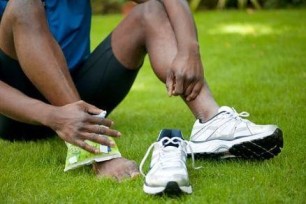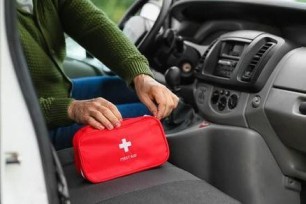General Insurance Blogs, Articles & Updates by - Magma HDI
Have us call you
- RENEW YOUR POLICY
- BUY NEW POLICY

Here are a few effective ways to heal injuries faster
In traversing through a fast-paced life, accidents are bound to occur. You might skip a step while rushing down to get your cab or cut your finger while chopping up vegetables, or simply fall and injure yourself while playing your favourite sport. Ideally, we would all want to lead a life without injuries and worry about medicines and post-care. But as someone has rightly said, "Falling is part of life, getting up is living." So, we're here to help you heal your injuries without burning a hole in your pocket.
Medical care costs are skyrocketing, and it is always the best option to get individual personal accident insurance to ensure the best coverage for severe injuries. But, for instant relief from minor injuries, you may focus on aiding the process of recovery and healing yourself faster. So, let's look into it to make our healing process quicker.
1. RICE:
RICE is an acronym for REST, ICE, COMPRESSION, ELEVATION. It is used for mild sports injuries. As the names suggest, one should give ample rest to the affected area, keep applying ice packs, and use a medical bandage for compression. Keeping the affected area elevated above the heart's level is suggested to reduce pain and swelling.
2. Eat the right food:
Certain food items possess the ability to catalyze the healing process. For example, protein-rich food like eggs, meat, cottage cheese, and citrus fruits like oranges have anti-inflammatory properties and help build ruptured tissues.
3. Wash the affected area:
In case of open injuries, washing the wound with clean water and cleaning the area with saline solutions is suggested to avoid the accumulation of bacteria.
4. Anti-bacterial ointment can do wonders:
Getting the wound examined by the doctor and applying a prescribed ointment to open wounds is highly suggested as it prevents infections and helps in faster healing.
5. Turmeric paste:
This golden formula from grandma's corner is a no-fail solution to any wound. Turmeric has anti-bacterial, anti-fungal, and anti-inflammatory properties. In addition, the curcumin present stimulates growth and helps faster restoration of the wounded area.
6. Apply pressure in case of blood loss:
It is suggested that in case of blood loss, one should maintain pressure in the affected area to avoid anaemia and ensure a faster recovery. Excessive blood loss can be a life-threatening condition. If the bleeding persists, one should see a doctor at the earliest.
7. Stitches or staples:
If the wounds are deep, it is essential to go to the doctor and get stitches or staples. Leaving them open for a prolonged time may hinder the growth of new blood vessels and prevent the wound from closing. While these procedures can be expensive, you can rest easy if covered by individual personal accident insurance.
So these are a few ways that can help you in your journey to healing yourself faster and getting back in the game. Your body is a temple, and giving it proper rest and care after injuries will help you regain your former strength sooner than you think. It is always suggested that you go to a doctor and get your injuries examined, but these remedies can help if they aren't significant.
Click HERE to get details about the different individual personal accident insurances.
Disclaimer: The information provided above is for illustrative purposes only. To get more details, please refer to policy wordings and prospectus before purchasing a policy.

The best reasons to opt for sports bikes for touring and adventure
A sports bike provides riders with an exhilarating and adventurous experience. Several high-quality sporty bikes have recently entered the market, each with its own unique set of features. In addition, sports bikes have a more upright riding position, long travel suspension, and bigger tank capacity.
Long travel suspension contributes to optimal ground clearance, allowing smoother driving over rugged terrain, which makes it possible for motorcyclists to travel into distant locations with ease. Potholes and roadblocks are no match for their speed and agility.
The following are the ultimate five reasons you should ride a sportbike for touring.
1. Customisation:
A sports bike is more convenient than a regular bike when it comes to touring. Buyers can improve the quality and crash safety of their bikes with the help of after-sale services. Every accessory is protected against rain, snow, and hail with an all-weather coating for added durability.
Helmets and riding clothes can be made just for you. It assists you in planning your outfits for road trips and prepares you for outdoor adventures. By your requirements and the location of the destination, you can select from a variety of tire options available in the market.
2. Enhanced convenience:
Seating comfort is crucial for every motorcycle rider, and many sports bikes offer it. In addition to traction control, an anti-lock braking system and several temperature riding modes make sports bikes equipped with exclusive features that assure riders' convenience. Furthermore, it provides several other technologies that make riding a motorcycle safe and enjoyable for long journeys.
The bikes are developed with practical features such as cruise control and heated seats for added comfort.
3. Serviceability and dependability:
Sportbikes are relatively simple to maintain and repair. The reduced bodywork makes routine maintenance, inspections, engine cleaning, and other vital components easier.
Because these bikes are engineered to withstand gruelling conditions for an extended time, their parts and materials are overbuilt for most types of travel. More than any other bike, their durability quotient is high. They are more powerful and torquey in technology, with designs that are fashionable.
4. Touring experience:
Touring is about more than just your vehicle. It is also essential to have a positive experience. You will undoubtedly meet and engage with other riders. Also, sports bikes have a reputation for igniting conversation with curious locals about your origins and destination.
You get to participate in many chats that will leave you with a slew of pleasant memories. A growing number of individuals are developing an interest in sports bikes. Keep an eye out for activities in your area, and don't be hesitant to drop over with your camping gear if you see one.
5. Greater fuel storage capacity:
It is common for sports bikes to have a bigger tank capacity, between 13 and 20 litres. A larger tank equates to a more excellent range of operation. In addition, it eliminates the need for numerous stops for refuelling when travelling long distances. The fact that petrol stations are far and few when you are travelling makes this feature all the more crucial for your trip!
In a nutshell, sports bikes make it possible to cover vast distances with ease, unmatched speed, and durability. It is well worth purchasing for any lengthy journey because of its design and comfort. Feel the seamless power of the engine revving your heart and exciting the rider in you.
If you have a passion for travelling on two wheels, then a sportbike can help you live your passion to the fullest. However, apart from the fun, you need to prioritise your safety while riding such powerful machines. Ride with proper safety gear and invest in 2 wheeler insurance to safeguard your finances against any damages.
Click HERE to purchase the best 2 wheeler insurance for your sports bike.
Disclaimer: The information provided above is for illustrative purposes only. To get more details, please refer to policy wordings and prospectus before purchasing a policy.

Practicing farming can have a positive impact on your life. Know how
India is an agricultural-based country, where farmers and farming have an exponential impact on the whole country. The concept of farming should not just be confined to the villages or rural areas. Rather than perceiving it as a profession, it should be practiced as a hobby that can offer several valuable experiences.
Have you thought of maintaining your own farm? This thought might have crossed your mind at least once, but you might be wondering how farming can be helpful to you. It might sound surprising to most city dwellers, but yes, farming in your backyard, lawn, or terrace can positively impact our lives. Let's know-how.
1. Creates multiple opportunities:
The farming sector is booming with many promising job opportunities. The growing demand for education and significant research in the farming sector brings many new opportunities, such as farms, nurseries, and hatcheries.
2. Maintain the economy:
The increasing population can meet the rising job opportunities in the farming sector. This ensures that the demand and supply balance is maintained. As a result, the prices of food and other products stay level for the consumers.
3. Teaches emotional investment:
Growing a crop is what nurturing a child feels like. You sow the seeds at the earliest stage and make sure they grow properly. You provide all the other nutrients and protect the seeds and saplings against harsh wind, heavy rain, and excessive sunlight. You choose suitable pesticides to ensure that the bugs and other insects don't destroy your crops. The whole cultivation process requires a lot of capital, physical labour, and emotional investment. Patience plays a huge role here. Understanding how emotions develop throughout the entire growth helps in the long run.
4. Medicinal purposes:
Many crops and plants act as medicines rich in various nutrients and minerals. Several medical practitioners advise their patients to consume the processed version of these plants (or even raw) to treat nausea, morning sickness during pregnancy, kidney stones, etc. Many of these crops are cultivated to feed the cattle and livestock and get the best quality of dairy products.
5. Saves water and soil:
The roots of the crops hold the soil tightly, thus avoiding soil erosion due to severe climatic factors like heavy rain or wind. This helps keep the nutritional value of the top layer of the soil, which is essential for the growth of plants. Practicing farming also helps avoid the drainage of toxic chemicals into the rivers or seepage into the water table.
4. Self-assurance:
It will help if you build a strong anti-nausea mindset. Keep reciting to yourself that you will not feel sick or nauseous. This prepares your brain to think flying is normal and there is no need to fear. You will gain confidence and reassure your body to stay calm, especially during stressful moments. Ask a friend or travel companion to help you when you feel nauseous.
6. Sustainability:
Farming crops that provide biodegradable products like cotton, paper, wool, etc., contribute immensely to sustainability. Due to the excessive pollution and increased usage of non-biodegradable products, there is a massive negative impact on the climatic conditions. Sustainability is a huge influencing factor in saving our planet against significant issues like global warming and climate change.
Those were some of the pointers on how practicing farming can significantly impact your life. Farming connects you directly to the soil, and the moment you feel the soil, you reap good outcomes. This sublime connection will leave a positive impression and bring out the best version of yourself.
Your contribution through farming does not mean just growing crops. It highlights your contribution to boosting the economy, promoting sustainability, and encouraging healthy living. Farming enables access to a variety of healthy food products, which help in building strength and immunity in people of all age groups. And with global health standards getting a massive blow, it becomes more important to address health issues with seriousness.
Just like you protect your precious crops from getting damaged by using the right pesticides, it is vital to safeguard your and your loved one's health. You can accomplish this by purchasing the best health insurance policy. Make a hassle-free purchase and buy health insurance online to benefit yourself with the best premium and returns on investment.
Click HERE to know more about how you can buy health insurance online.
Disclaimer: The information provided above is for illustrative purposes only. To get more details, please refer to policy wordings and prospectus before purchasing a policy.

Why a first-aid kit in your vehicle is an excellent step towards safety
Justifying the name, first-aid kit is the immediate response of medication at the time of emergency. Those initial moments can help prevent an injury from getting critical during an accident and can potentially save the life of someone on the road.
A first-aid kit in the car is essential for many situations that don't require the help of a medical professional. Most of us spend our time travelling, either for work, holiday, shopping or long drives during weekends. Unfortunately, with roads becoming more prone to accidents, the probabilities of mishappening are common.
In such situations, having a first-aid kit in your vehicle enables you to avoid severe complications until help reaches you. For the minor injuries, a first-aid kit will be a saviour to cure cuts, scratches, and other minor wounds.
The advantages include:
• Helps prevent injuries from getting worse: It is crucial to address the minor cuts or wounds developed after accidents before they turn septic. Leaving the wounds open will invite infections, and in no time, you will start feeling weak. Avoiding such situations by using first-aid is the best thing to do. Soak the cotton with antiseptic liquid and gently apply it over your wounds or scars and clean the area thoroughly. Later, use bandages to cover the wounds and let them heal at their own pace.
• The belief of being safe: Having a safety kit in the car will give you the mental satisfaction of having resources ready in case of emergencies. It makes you feel prepared to take good care of yourself even when driving solo. Another add-on to this belief is valid car insurance, which provides financial protection against any eventuality.
• Be the saviour in the crowd: If you ever witness any severe accident, having a first-aid kit will make you the first responder. You can treat and bandage the wounds to prevent excessive blood loss that can deteriorate the injured person’s health. Remember, your alertness and courage can save a life.
Must-haves in your first-aid kit:
A first-aid kit is a personal resource for emergencies, and everyone may keep them equipped with the accessories they think they may need. However, here is a checklist of some essential items that should be in your vehicle's first-aid kit.
• Cotton (swaps) and bandages
• Basic antibiotics, antibiotic cream and pain relief spray
• Hand sanitizer
• Antiseptic wipes and antiseptic liquid
• Safety pins, scissors and a tweezer
• Gloves
• Rehydration sachets
• Torch with extra batteries
• A thermometer
You must check these necessities before you pack your vehicle's first-aid kit. Additionally, ensure that you keep a list of contact numbers (family, friends, doctor, etc.) so that in case of any severe injuries, someone can reach out to your close ones and inform them about the event.
Preparedness can prevent unexpected situations from getting worse for you. Whether you are travelling alone or travelling with your friends or family, you shouldn't compromise safety. The earlier you understand the importance of having a first-aid kit in your vehicle, the better it’ll be for you.
In addition to it, for the safety of your car during mishaps, consider getting car insurance. Although having car insurance cannot prevent accidents, it can assure financial security during emergencies. As it is rightly said, "It's better to be safe than sorry". With these small precautionary measures, you can keep big troubles out of your way. So, travel safe, travel responsibly!
Click HERE to get the best insurance for your car.
Disclaimer: The information provided above is for illustrative purposes only. To get more details, please refer to policy wordings and prospectus before purchasing a policy.


